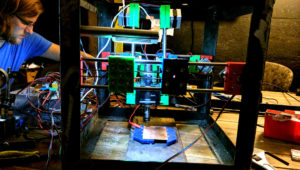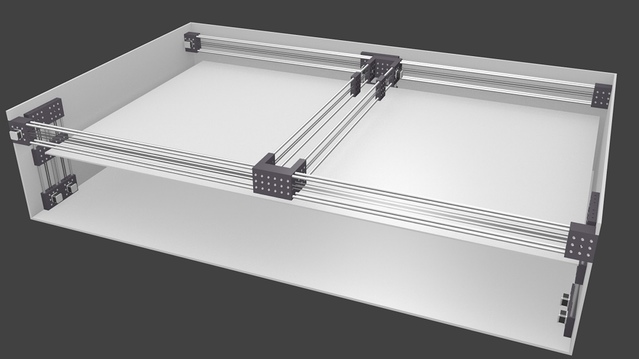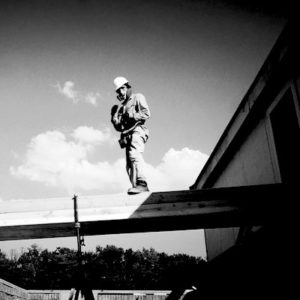
October 14-15, 2017
Factor e Farm
Maysville, Missouri USA
Build Yourself. Build Your World.
The Open Source Ecology CNC Torch Table Workshop is an immersion experience where we will build a working CNC torch table from scratch. The design is OSE’s own open source design, using the Universal Axis system. This torch table uses the 1″ unviersal axis for the motion system:
CNC Torch Table
The CNC torch table consists of 3D printed parts, metal plates, steel rods, stepper motors with belt drive, and the supporting structure. The specifications are:
The design focuses on minimizing part count and integrating the design with other machines of the Global Village Construction Set (GVCS). As such, we are using Nema 17 stepper motors and 6mm GT2 belt – the same as on our 3D printer. This pushes the limits of modularity and scalabilility – reducing overall GVCS parts count significantly.
See one of the 5′ axes being built –
https://www.youtube.com/watch?v=JOH03vzDYQg
We will be using this type of carriage with metal plates to provide rigidity while allowing the use of 3D printed parts:

A Scalable, Modular CNC Construction Set
The CNC Construction Set is a set of building blocks that allows you to build a CNC machine of any size. It can be used to build other machines including a 3D printer, a CNC Router, and a CNC Laser Cutter, a heavy duty CNC mill, and many others.
While there are many different CNC machines available, there is no construction set for building CNC machines on the market. We decided to fill this gap – utilizing our usual Construction Set approach. We also decided to design the simplest possible construction set. We have gotten the unique parts count down to about 40 – which is half or less of a typical CNC machine. We are designing a system intended to be scaled for industrial applications – consistent with our work on the Global Village Construction Set.
Construction Set Design
To create a Construction Set – we designed a small set of identical parts that can be reconfigured. The core part is the open source OSE Universal Axis Module. The same axis module can be used in the x,y, and z directions – to create the x-y-z motion system:
Using this Universal Axis and taking advantage of the Construction Set approach, we have already built 3D printers:

and an open source CNC circuit mill. We reconfigured the axes compared to our 3D printer, and added a small router.

After the CNC torch table, our next iteration will be a CNC machine one with 2″ diameter rods – making it a heavy duty CNC mill.
The metal guide rods can be larger or smaller – such as 1″ rods for the CNC torch table. The same axes as used above can be joined, lengthened, or stacked to build a much larger machine – such as this 4’x8’x1′ CNC Router:

Note how the basic axis unit and its ability to connect to other axis units allows for a wide range of design variations, putting the ability to design CNC machines within the hands of ordinary people. Depending on the tool head that is used – the machine can have the functionality of the corresponding tool head – whether a 3D printer extruder, a router, a laser cutter, a cutting torch, or many others.

Parts can be stacked in multiples, as in this 9-headed production 3D Printer shown printing more parts for the axis unit:

Lowest Unique Part Count in the World
The beauty lies in an absolute minimum number of parts that are used to build an infinite variety of CNC machines – depending on size, axis configuration, and tool heads. The unique part count is in generaal around only 40 parts- about half or less of comparable machines.
By making our machines simple and universal, we are aiming for the most widely replicated CNC build system in the world. To that end, we are inviting developers and entrepreneurs to join the OSE Development Team.
This workshop intends build upon OSE’s Extreme Manufacturing approach of rapid building with multiple teams working in parallel on modular components. By simplifying the design and streamlining the build with digitally-fabricated, open source parts – we intend for several of the CNC torch tables to be built by a team in a single day. Our goal is to develop open source microfactories for distributed production – using the Experience Economy and Social Production.
We are also developing an open source enterprise model for how to run such workshops anywhere in the world. We are publishing our enterprise model openly, with all supporting information that helps people in a successful startup – without reinventing the wheel. We will also be offering 6 week immersion training where strong candidates can learn to replicate our workshops to start a small business.
Workshop Expectations
This workshop is experimental, and not a turnkey product. We have significant experience with the topics covered, but surprises always come up in an experimental build. We have thorough CAD documentation of the machine. We have good familiarity with Cura, which is our 3D printer software – which we will use to send g-code to the controller to run the CNC torch table. We have tested the motion system with belt drive using the larger TB6600 controllers. We have developed and tested the height controller. We have built a different version of the CNC torch table already back in 2011 for a production run of 4 tractors:
While we have done extensive design work, and prototyped the different parts – this workshop is a first complete build. Expect to problem solve – and learn a lot in the process. This is an immersion learning experience in design and build. The worst case achievement scenario would be that we get the automated machine going in the xy plane – so we an cut steel with it, but we may not have the torch height controller installed, nor automatic gas turn-on so that the oxygen will have to be turned on manually for cutting metal. In the ideal scenario, we will implement fully automatic control, including height control, automatic gas turn-on, and automatic flame ignition. We will practice cutting on sample 1/4″ and 1/2″ thick steel.
The first day covers use of FreeCAD, and explanation of the design rationale for the CNC torch including all its components, and why we made the choices that we did. We will teach participants the basics of FreeCAD – literacy in manipulating 3D objects as well as modifying their geometry. We will provide an introduction to KiCad for electronics design – of the CNC torch height controller. We will have 2-4 3D printers printing during the workshop to produce additional parts (cable chain + other parts). How far will we get to completion? It’s up to us. The risk factors are system integration from proven parts.
If you want an immersion lesson in FreeCAD, please make sure to download the OSE Linux, which can be run on your computer from a USB stick without interfering with your operating system. This Linux has the FreeCAD and other software that is necessary to work with the CNC torch table. If you use the OSE Linux, it will be guaranteed that there are no software issues getting in the way of your learning.
While we do not require prior skill to join this workshop – the more skill that we have in the team of participants, the better will be the result. We expect people to work together as a team for a common goal, and we like it when participants teach one another new skills.
For development work, we invite our participants to join our development team. During the workshop itself – expect to do some problem solving – as building a machine of high complexity typically has surprises.
The intended audience for this workshop is hackers – people who want to get their hands dirty – who are interested in the design and build of hardware. The intended audience is anyone interested in exploring the meaning of Open Source Product Development. We’ve been pioneering techniques of collaborative development for several years.
But be prepared – this is not for the faint-hearted. Our facility is raw and crude – a farm in the middle of nowhere, Missouri. By attending, you are helping us carry out our open source development mission.
Bring a Friend for Free
We also have a 2-for-1 offer . You are welcome to bring one friend or family member with you for free.
Additional Information
For more perspective on the Global Village Construction Set, see the Global Village Construction Set:
Open Source Product Development Invitation
Workshop immersion involves concept and practice, and includes a crash course on Open Source Ecology. Participants become engaged in a part of OSE’s development process, where we produce open source blueprints for the infrastructures of civilization. Participants are introduced to basic principles of collaborative literacy – how the collaborative mindset can be used to solve wicked problems.
This workshop is intended for people interested in immersion, hands-on skills training and practical results. We are especially seeking participants with an entrepreneurial mindset to expand open source production into the mainstream. We are exploring the potential of open source economics by determining the limits of social production: can distributed, collaborative, community supported manufacturing (CSM) be an alternative to centralized factories? The overall workshop is designed for people interested in transitioning from consumer to producer. We welcome both complete novices and those with experience. The critical part is willingness to learn.
By joining this workshop, you have an opportunity to be part of a community interested in developing products collaboratively and open source, so that everyone can benefit. OSE’s goal is to promote right livelihood using open source – and part of that is starting enterprises. We are promoting the concept of distributive enterprise.
Have questions? Drop us an email: info at opensourceecology dot org
Instructors

- Marcin Jakubowski (USA)- Marcin was trained as a fusion physicist. He left academia right after finishing his Ph.D. to start a farm – in Missouri – and founded Open Source Ecology. For the last 7 years, he has been working on the Global Village Construction Set – a set of enabling tools and machines for building regenerative infrastructures. Marcin is passionate about creating the Open Source Economy – a new operating system for Earth. See Marcin’s bio.
CNC Torch Table Design
- Basics of FreeCAD and KiCad. Viewing and modifying designs.
- Basic working principles of a CNC Torch Table
- How to build a CNC Torch Table
- How to calibrate a CNC Torch Table
- How to run software to control a Torch Table
- How to create cutting files
- Different types of metal cutting systems for a torch table
- Applications of a CNC torch table
Collaborative Literacy
- Basic principles of Open Source Ecology
- The concept of Open Source Product Development (OSPD)
- The meaning of Distributive Enterprise
- Basic collaboration principles of open source projects
- How to engage in a collaborative documentation process
- The concept of module-based design
Distributive Enterprise
- Business model for Distributive Enterprise
- Extreme Manufacturing
- 100x Efficiency Improvement via Open Source Closed-Loop Production
- The meaning of Viral Replicability Criteria
Note: schedule is being refined and may change slightly. The full program goes from 8 AM to 8 PM each day.
Day 1:
- 8 AM: OSE + Event Introduction
- 9 AM: FreeCAD basics. KiCad basics.
- 10-10:45 AM: – Practicing FreeCAD. Manipulating the CAD. Navigating in tree view. Redesigning components from sketches. Generating technical drawings. Printing out sample drilling patterns for steel plates. Generating a complete part list from FreeCAD.
- 11-Noon – Extracting CNC cutting files from FreeCAD. G code generation. Cura controller. Wiring diagrams for the controller in Fritzing.
- Lunch
- 1 PM: Build beginning. Drilling, 3D printing. Building the XY Axes. Buildig the Z axis. Wiring of the controller. Building the torch height control system. Building the gas control system.
- 6PM: Dinner
- 7-8 PM: Review and Learning Discussion. Universal Axis Roadmap to heavy duty precision machining. OSE Developers. OSE revenue model. Q&A + discussion session.
Day 2:
- 8 AM: Morning check-in. How capacitive sensors work. How ultrasound sensors work.
- 9-12 AM: Build continuation.
- Lunch
- 1-6: Afternoon Build Session. First cuts.
- Dinner
- 7-8 PM: Review and Closing Discussion
Early Bird Registration: $145. Bring a friend or family member for free.
Early Bird Admission ends on September 30, 2017 at 7 PM CST USA time. The registration goes up to $165, but you can still bring a friend for free.
Group Rate: Email us if you would like to bring a group.
True Fans of OSE: As supporting members of OSE, True Fans who have been subscribed for 6 or more months receive a 25% discount on all of our workshops. Email us for details. You can sign up as a True Fan now to become eligible for the True Fans discount on future workshops.
Sponsor another participant or Donate to OSE: We are a nonprofit organization with 501(c)3 status. You can make tax-deductible contributions to us. Sponsor $145 to fund attendance of someone who is on the waiting list for financial assistance by making a donation. We receive low-income assistance requests for all of our workshops.
Logistics: Email us if you would like to bring a group. We will provide continental breakfast and dinner. Lunch is on your own. We have a barbecue grill and a kitchen available at HabLab, so feel free to bring ingredients. You will be responsible for your accommodations, and wild camping is available on site. If you would like to stay in the HabLab, our shared room dormitory, you may also do that.
Payment Options: PayPal, Credit Card, Dwolla, Bitcoin, Check, Money Order, Wire Transfer, or Cash
Registration for the choices above is found on Eventbrite, but Eventbrite accepts only PayPal or Credit Card. If you would like to pay by other means you can select that option at Eventbrite, but then you have to submit your payment independently of Eventbrite. We accept Dwolla, Bitcoin, Check, Money Order, or Cash. Your registration is complete upon receipt of payment. If you pay with Dwolla – Dwolla charges lower transaction costs than PayPal. If you are paying by Dwolla, register at Eventbrite and select the Dwolla option, then pay independently via Dwolla (Dwolla is not currently integrated into Eventbrite). Use Open Source Ecology or ops@opensourceecology.org as the Dwolla recipient. Bitcoin is a decentralized payment system. You can pay via a bitcoin amount translated by the current bitcoin exchange rate on the day that you register. OSE’s Bitcoin Address is 166yC48RakrZdtsBj36vY9q29CpzknHbxY. If you are paying by check, please make checks payable to Open Source Ecology. Our mailing address is OSE, 909 SW Willow Rd, Maysville, MO 64469. For mailings, please write “CNC Torch Table” in the memo line on your check. For wire transfers, please email us at ops@opensourceecology.org for further directions.
Cancellation Policy
If you need to cancel for any reason, we will be happy to (a) transfer you credit towards another workshop in the future; (b) substitute the name on your ticket and have a friend take your place.
Registration on Eventbrite
Please use the the Eventbrite form below to pay with PayPal/credit card. Eventbrite charges a small fee.

Comments are closed, but trackbacks and pingbacks are open.